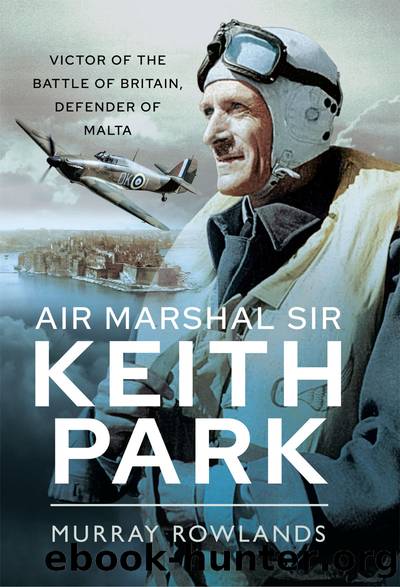Air Marshal Sir Keith Park by Murray Rowlands

Author:Murray Rowlands
Language: eng
Format: epub
Tags: BIOGRAPHY & AUTOBIOGRAPHY / Aviation & Nautical
Publisher: Pen and Sword
Published: 2021-11-15T00:00:00+00:00
Chapter 15
The Battle goes on
To make matters worse for Park, Leigh-Malloryâs 12 Group began to agitate about how he could have been used to greater effect, and claimed that the squadrons attached to 12 Group were being deliberately excluded from the conflict. One of his young pilots, Hugh Dundas, describes sitting on the ground in his plane while a life and death conflict was taking place in the 11 Group area. There were claims that appeals for help from 11 Group arrived too late for 12 Group to make an effective intervention. Park countered by saying that this was because they were taking too long to assemble in a formation before going into action.
Since large-scale attacks had commenced on 8 August, the Luftwaffe had lost 350 aircraft. It was slowly dawning on Göring that the RAF was a far tougher nut to crack than he had imagined. Said Churchill: âThe gratitude of every home in our island, in our Empire, and indeed throughout the world, except in the abodes of the guilty, goes out to the British airmen who, undaunted by odds, unwearied in their constant challenge and mortal danger, are turning the tide of the World War by their prowess and devotion⦠All our hearts go out to the fighter pilots, whose brilliant action we see with our own eyes day after day.â
But on 19 August there was a staff conference. In attendance were Air Chief Marshal Dowding and the commanders of each of the Fighter Command groups. Park was at pains to highlight how crucial it was to defend 11 Group airfields and in particular Kenley and Biggin Hill: âNow Göring knows he can penetrate our inner airfields there will be no stopping him from continuing,â he told the conference. Nowhere on the British side was the crisis more evident than in 11 Group, under the heaviest pressure from the armada Göring was now sending against them. Although impressive results had been achieved it seemed impossible to quell the German attacks. Attacks against crucial airbases at Kenley, Lympne, Hawkinge, Manston, Martlesham, Rochester and Croydon had underlined the groupâs vulnerability. Essentially a war of attrition was developing and Park was fully aware that the resources available to him might not be enough. The debit side was showing 211 single-engine fighters lost and 154 experienced pilots. Dowding was asking himself: âIn a monthâs time, how many pilots and aircraft will I have at my disposal?â
Park was well aware of the psychology behind many of his pilots being drawn into combat with other fighters and preferring this to the essential task of shooting down German bombers. Fighter-to-fighter combat was costing too many pilotsâ lives and destroying too many aircraft while German bombers were penetrating British targets.
Park published Directive Number 4:
⢠Use fighter aircraft to attack the large enemy formations over land or close enough to land for our own fighters to be able to glide to the coast if they are damaged. For the next two or three weeks, we cannot afford to lose pilots through ditching in the sea.
Download
This site does not store any files on its server. We only index and link to content provided by other sites. Please contact the content providers to delete copyright contents if any and email us, we'll remove relevant links or contents immediately.
Harry Potter and the Goblet Of Fire by J.K. Rowling(3025)
Unfinished: A Memoir by Priyanka Chopra Jonas(2912)
Never by Ken Follett(2873)
The Man Who Died Twice by Richard Osman(2291)
Machine Learning at Scale with H2O by Gregory Keys | David Whiting(2269)
Fairy Tale by Stephen King(2059)
Will by Will Smith(2033)
Rationality by Steven Pinker(1761)
The Storyteller by Dave Grohl(1656)
The Dawn of Everything: A New History of Humanity by David Graeber & David Wengrow(1565)
The Dark Hours by Michael Connelly(1563)
The Stranger in the Lifeboat by Mitch Albom(1529)
Cloud Cuckoo Land by Anthony Doerr(1428)
The Becoming by Nora Roberts(1324)
Friends, Lovers, and the Big Terrible Thing by Matthew Perry(1324)
Einstein: His Life and Universe by Walter Isaacson(1312)
Crying in H Mart by Michelle Zauner(1312)
New Morning Mercies: A Daily Gospel Devotional by Paul David Tripp(1305)
A Short History of War by Jeremy Black(1295)
